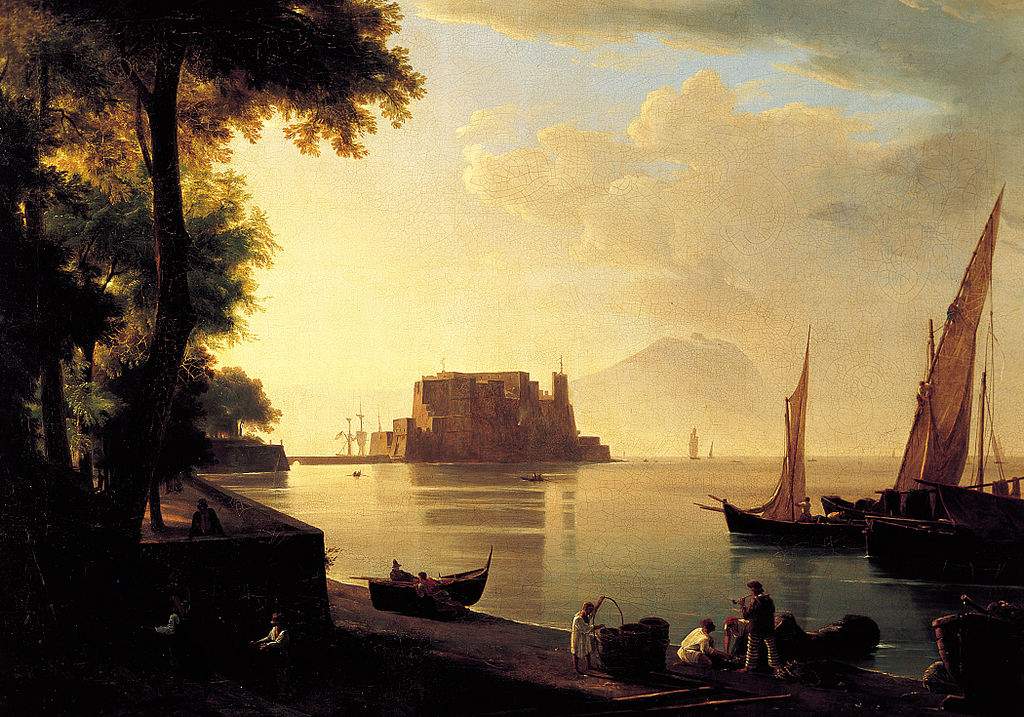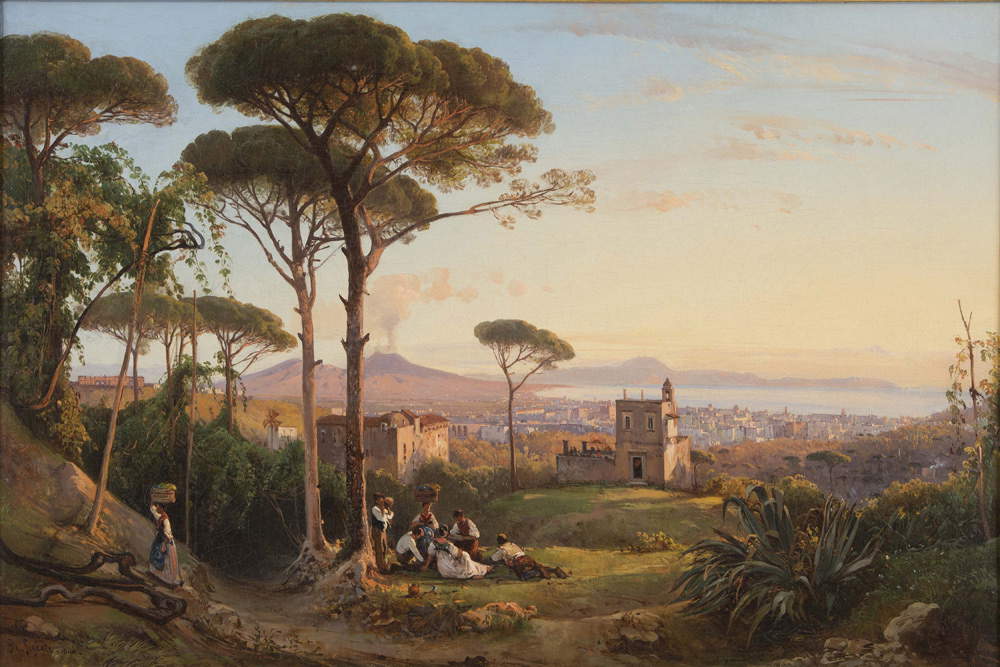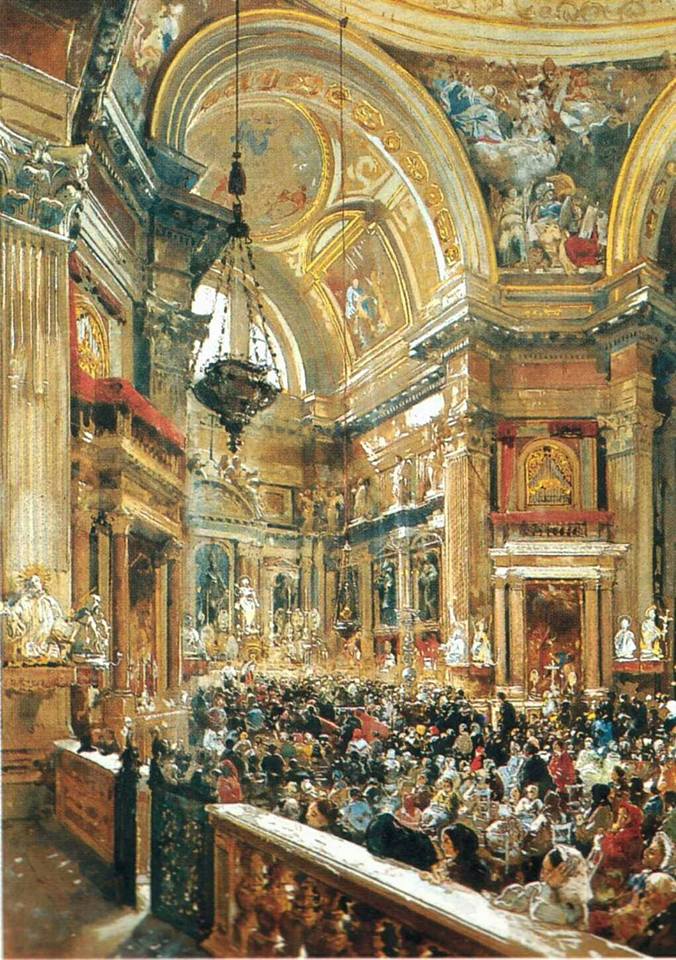The Posillipo School was a pictorial experience of a group of artists gathered in Naples, beginning in the second decade of the 19th century, devoted mainly to landscape painting practiced outdoors. The School was inaugurated by the Dutch painter Anton Sminck van Pitloo, who led it until 1837, later passing to his Neapolitan pupil Giacinto Gigante. It represented an important moment for local Neapolitan and Italian painting, within a broader European context that tended toward the celebration of the landscape genre beyond its ideal and historical representation.
Pitloo, inspired by Parthenopean landscape beauty and customs, succeeded in capturing and conveying to his pupils the atmospheric values of nature by establishing a personal, rapid, brightly spotted brushstroke. Gigante, as a representative of a family of painters who clustered around Pitloo, inherited Pitloo’s inspiration and, accentuated the use of stain and ’impression from life, rendering movement and light, liveliness and typical Neapolitan character in his works. The local natural elements, architecture and inhabitants, exerted a strong attraction on at least two generations of painters.




While in France Paris was the ultimate center of attraction and hub for 19th-century artists, Italy was divided into many political and cultural circles and struggled to find a pictorial language that went beyond provincial boundaries. Naples, which was a political and cultural center where foreign painters also converged as a stop on the Grand Tour and where a tradition of landscape painting had been circulating since the seventeenth century and throughout the eighteenth century with a wide spread of tourist vedutismo, experienced a prolific moment with the Posillipo School.
In 1816 the Dutchman Anton Sminck van Pitloo (Arnhem, 1790 - Naples, 1837) arrived from Rome and cultivated his artistic interests in the city, finding an ideal patronage and a fruitful stimulus for his work, so much so that in 1820 he founded a private school of painting. Thus was born the Posillipo School, which already found wide acceptance in the decade 1825-1835. It was so named because observation of the city took place from the heights of Posillipo, a hillside district that allowed views with panoramic perspectives.
Pitloo painted, with a personal interpretation of the landscape, pictures destined to be particularly appreciated by new generations of painters and which earned him the consideration of “one of the most brilliant artists of the time.” From 1822 he became a professor at the Royal Institute of Fine Arts in Naples and established himself as an international artist. Indeed, he succeeded in maintaining contacts with the European art milieu and with artists such as Jean-Baptiste Camille Corot (Paris, 1796 - Paris, 1875), an important French landscape painter who in the 1820s was a forerunner and influential supporter of the Barbizon School. In reaction to the stylized and idealized representations of figures and landscapes of Neoclassicism, most Barbizon artists along the 1930s approached landscape painting in a naturalistic way, capturing the scenery they saw truthfully, making careful observations and painting outdoors to faithfully reproduce the colors and shapes of the countryside. Corot, who visited Naples between 1817 and 1821 and in 1828, in turn exported the experiences he had in Italy during his Grand Tour, which, as was the widespread custom at the time, included stops in Italy’s most important cities of art.
At the same time, in the first half of the 19th century, the spirit of the Romanticism painters were spreading in Europe, who turned their attention to nature and outdoor painting, in works based on close observation of the landscape, sky and atmosphere, devoting themselves to depicting the subjective reaction, the inner life in relation to the surrounding nature.
Pitloo also got to know the work of the most important English landscape painter of the time William Turner (Covent Garden, 1775 - Chelsea, 1851), who was present in Naples between 1819 and 1828, from whom he picked up the Romantic moods, aimed at a free interpretation of nature, later transfused into his schooling to his students at Posillipo. In addition to what might have been favorite places in the depiction of the Neapolitan area, such as Vesuvius, the excavations of Pompeii and Herculaneum, and the islands of the gulf, the Posillipo painters turned to depicting nature around the urban area and its bright Mediterranean atmosphere.
To the Posillipo School belonged many young artists destined to become proponents of a renewed fortune in landscape painting, the most significant of whom were Achille Vianelli, Gabriele Smargiassi, Teodoro Duclère, Salvatore Fergola as well as Giacinto Gigante (Naples, 1806 - 1876), who, upon Pitloo’s death, gradually and for some years took over the reins of the school.
Giacinto was, as with many other followers, one of the representatives of his family who attended and supported the activities at Posillipo. The artistic enthusiasms had infected entire family units, such as The “Carelli” with his father Raffaele and three sons Consalvo, Gabriele and Achille, the “Fergola” with the progenitor Luigi, his two sons Salvatore and Alessandro, and Salvatore’s son Francesco; the “Witting” with Teodoro, an engraver, and his son Gustavo; and precisely the “Gigante” with Gaetano, father of Giacinto, who would become head of the family, Emilia, Achille and Ercole.
In what is considered the second phase of the School, from the 1940s onward, visions and styles changed, also in relation to the new realist tendencies-which in Naples were introduced above all by the brothers Filippo and Giuseppe Palizzi-and to the demands of patrons, which made the lyricism of painting carried on in Posilippo out of date. Until a gradual exhaustion of expressive vitality, between 1850 and 1860. Since 1851 Giacinto Gigante had entered as a professor at the Academy of Fine Arts in Naples, going on to an institutional career that led him in 1867 and 1869 to the Universal Exhibition in Paris.



Pitloo’s stylistic innovation was to introduce observation from life of nature and the rendering of transient effects of light and color from drawing, “en plein air” from preliminary sketches, much as the Barbizon School in France was experimenting with. The artist introduced in Naples the technique of oil painting on intel paper (mounted on canvas or cardboard), as Corot was experimenting with. The guiding idea was to reach the completion of the painting without second thoughts, and in such a way as to grasp the mutability of light, abandoning the use of an easel. Until the late 1920s his interpretation of landscape was still classical, before he devoted himself to the search for atmospheric rendering(The Castle of Baia, 1830). So that even the early production of the Posillipo School was more traditional, resorting to broad, perspective and scenic views, with bird’s-eye viewpoint elevated.
Pitloo over the years abandoned classicist vedutismo to move toward a decidedly more lyrical reproduction of the naturalistic datum, as understood by the Romantic painters of his contemporaries, in order to represent personal suggestions derived from direct observation of places(Castel dell’Ovo from the beach, c. 1820-1824).After his death from a cholera epidemic, his pupil, Gigante, became the most original interpreter of the poetics that wanted to add the emotional component to the landscape image, certainly influenced by Turner. Gigante arrived at updated stylistic results compared to European painting, emancipating Neapolitan landscape painting.
With his practice he changed the perspective from which painters looked at subjects, the artist having favored narrow fields of vision, foreshortening, and with the choice of also depicting people in the act of performing everyday actions. The countryside and the coast prevailed (Gabriele Smargiassi, Il golfo di Pozzuoli da Baia, 1841; Giacinto Gigante, Costa sorrentina, 1842) as well as city life, with constant variations of recurring themes. The value of the work no longer lay in the nobility of the subject, but in its realization, in the painter’s personal reaction to the theme. Gigante excelled in ’watercolor(Chapel of San Gennaro at the cathedral during the miracle of blood, 1863) and in representations of pure color(Sunset at Caserta, 1857), which would become customary in art only later with Impressionism.
 |
| The Posillipo School: landscape painters in Naples in the nineteenth century. Themes and styles |
Warning: the translation into English of the original Italian article was created using automatic tools. We undertake to review all articles, but we do not guarantee the total absence of inaccuracies in the translation due to the program. You can find the original by clicking on the ITA button. If you find any mistake,please contact us.